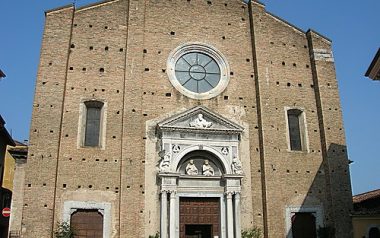Church St.Maria Annunziata
The Church St.Maria Annunziata, cathedral and ancient parish church of Salò, is located in the center of the town, almost at the lakeshore, stands tis church of great architectural value, which was built on the ruins of the parish church of St. Maria Annunziata, to which is still now dedicated .
Church St.Maria Annunziata, parish church of Salò: It was built according to the design of Filippo delle Vacche from Caravaggio dates back to 1453 and concludes in the early years of the sixteenth century. The late-Gothic style it’s mixed to some Renaissance details and the internal division into three naves reminds us the church of St. Anastasia in Verona, wich is the reference model; of the previous construction remain today the tower structure, the windows and the Chapter Room which houses XV century frescoes, while of the old decorations on the walls there is nothing left, especially following the earthquake of 1901 that profoundly changed the appearance of the church. In 1590 the Renaissance portal is built in marble by Gaspare from Coirano and by the end of the century the side chapels were opened and the decorations created by Tommaso Sandrini . In its interior there are precious paintings by Romanino, Zeno Veronese, Paolo Veneziano and frescoes by Antonio Vassilacchi ; important also the old crucifix of Giovanni Teutonico, carved in the early fifteenth century.
G.P. writes about the ancient church. Brogiolo: “Pietro, native of Puegnago and archpriest of the parish church of Salò, is mentioned in a document dated 1016 which also mentions Cacavero and the properties of the court of Gaugardo (Gavardo) and of the (monastery?) of San Faustino in Cacavero. The parish church St.Maria Annunziata had jurisdiction over the territory of the current municipalities of Salò, Roé Volciano, Gardone Riviera. …….. Filippo Tomacelli remembers that in 1453, when the present cathedral was built, the churches of Santa Maria and San Giovanni, probably the ancient baptistery, were demolished. An excavation essay, carried out adjacent to the northern perimeter of the Pieve and the Romanesque bell tower, identified a settlement phase of the 5th-6th century, which is not clear, however, whether it can be referred to a place of worship. ” A sensational event occurred in this church on May 29, 1610, during the period of banditry in the Magnifica Patria and generally on Lake Garda; the mayor of Brescia, Bernardino Ganassoni, was killed during mass, as we find quoted (A.S.V., Council of Ten, Criminals, reg.27, 4 August 1610) in the book by Claudio Povolo “Zanzanù, the bandit of the lake”

